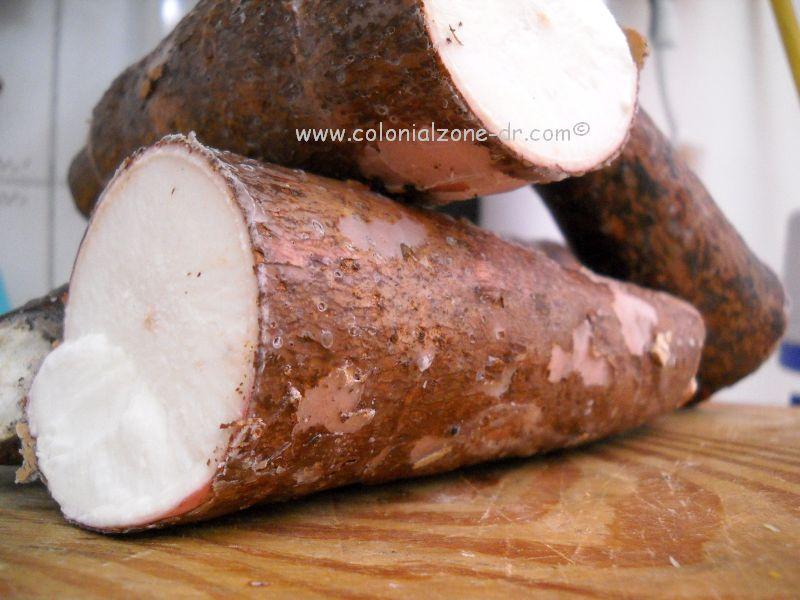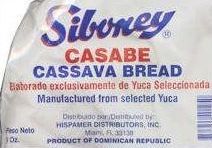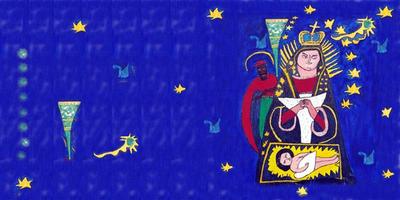Grown In Dominican Republic – Yuca
Yuca (pronounced jooka in the Dominican Republic) is also called manioc or cassava root. It is a favorite of Dominicans everywhere. This tuber is fairly easy to grow and can be prepared in many different ways.

The botanical name for Yuca is Manihot esculenta, not to be confused with yucca which is another plant entirely. The plant was originally from brought South America to the Caribbean islands. It is a woody evergreen shrub ranging in height from 6 to 8 feet tall. Ground, the leaves can be used in herbal remedies and the new flowers can be eaten.

Yuca is picked by hand the roots or tubers remind me of a giant, long, hard potato mixed with a deformed pithy carrot. The entire shrub needs to be pulled from the ground and the tubers removed. There are usually many tubers on a single plant. This root is 2 to 3 inches around and can be from 6 to 12 inches (I’ve seen longer) long. It can even look like a kid size, deformed baseball bat. One plant can produce many tubers. The tubers of the sweet yuca are a little smaller than the bitter variety. Yuca grows fast, is plentiful, and can grow from the roots left in the ground or by placing one of the tubers back into the hole where the plant was pulled (just like a potato).

Preparing Yuca
The two main types of Yuca are bitter and sweet. The bitter needs to be rinsed well to remove the poisons and the sweet can just be boiled or eaten raw if so desired.
The tuber is brown on the outside and has a white to cream colored hard flesh on the inside. They don’t have a long shelf life so make sure to put them in the fridge and use them within a few days. As soon as the white flesh is exposed to air it will start turning black. Usually the roots that are purchased in the stores are covered in wax or frozen. In some places you will also find the tuber covered in thick mud. This preserves the root as well.

Peeling is a real chore (you can cheat by putting them in the microwave for a few minutes or boiling with the skin on for a short time as this can make the peeling process a little easier). First make sure you have a sharp knife, as this tuber is quite hard and difficult to peal. Since it is so hard cutting it into smaller sections makes the job easier. As you peel the sections make sure to keep the peeled sections in water so they don’t turn brown. Peel the brown outside layer and the thin layer that is between the skin and the flesh. I find it is easier to boil the tubers in salted water for a short time to soften them up a bit, and then peel them. You can remove the core if it is yucky and stringy, if not leave it.
The sweet yucca, after it is cooked, can be eaten as is. I like to pan fry the cooked pieces and get them a little crispy. They are also great cut into strips and deep fried like french fried potatoes. They can be used like a potato and are good in stews and soups. These starchy tubers are an important ingredient in Sancocho. Yuca can be used to thicken up soup just as a potato does. Get some yuca recipes here.

Casabe
The original inhabitants of the island, the Taino Indians, made a bread using the bitter yucca root. Casabe or Cassava bread is made much the same way then as it is now. It is a Dominican cuisine staple and is a much-desired accompaniment for many typical Dominican dishes. With the commercial preparation of this traditional bread it is again becoming an everyday and readily available food. In the past this bread was made by the locals and distributed only locally by the homemakers that worked hard to make this labor intensive staple. This was a way to make money for their families. Now it is made commercially and is readily available throughout the island. It is even shipped to USA and elsewhere.
To make the Casabe the bitter yucca root must be prepared correctly, as the root is poisonous (containing hydrocyanic acid). The outside brown skin and the hard white layer underneath are pealed away. The core is also discarded and only the inner white flesh is used. The inner white flesh is grated using guayos. Then is soaked. The juice must be squeezed out either in a long canoe type vessel called a matapee or wrung out in a towel to remove the poisonous starch. It is then dried slightly in the open air. Then it needs to be pounded and sifted to make a flour. This flour is then spread on a large, heated, flat round iron pan or mold about 1/8 to 1/4 inch thick. Then it is baked atop a specially shaped oven, called a buren griddle, until set using moderate heat. It is then flipped over and cooked until done and left to dry in the sun until it is crispy.
Casabe bread is high in vegetable fiber, starch, calcium and Vitamin C. It has a very low fat content and is also low in protein. It is can be eaten by persons who are gluten intolerant. This thin, hard round bread can keep for many months without getting stale or moldy. It is used to accompany many Dominican dishes. It is a must have with Asopao/ Soup and Sancocho (I like to just drop it in and let it get soft). It is great baked with a little green (olive) oil and salt. It can be used as a tortilla chip and dipped into just about any dip one could imagine because of its subtle flavor. Slap on some jam and use it like bread. Toast it and use it for dunking in coffee, tea or cocoa. There are so many ways to use this versatile food.

Interesting Yuca Facts and Legends
*Tapioca is also made from the cassava flour, which is also known, as tapioca flour. The pearls and starch of tapioca come from this plant.
*Cassava flour (tapioca flour) is commonly used as a food thickener and is also used as a binder in pharmaceutical tablets.
*Yuca is also the name given to rock music in Venezuela
*The extract from the plant has been used with surprising success on arthritis and rheumatism sufferers in herbal remedies/ Hierbas Medicinales
*The bitter variety may be used to treat scabies, diarrhea, and dysentery. Manioc flour may be used to help dry weeping skin.
*The plant has already been used to eradicate brain tumors in laboratory rats.
*If you’re on a diet 1/4 cup of yuca (considered a starchy vegetable) can count as a starch/ grain serving (according to the
South Beach Diet plan). It is a type B carb falling between brown rice and a baked potato.
*Use starch from the yuca the same way you can use cornstarch
*In old times it was added to wet laundry before ironing as a clothing stiffener.
*Dominican empanadas, deep-fried dough pockets stuffed with meat, are made with yucca flour.
*Panesico are baked logs of yucca flour and pork fat and are considered a specialty of the Cibao region.
*Bolas de yuca are deep-fried balls of yucca flour.
*Jojadra are powdery ginger cookies made of yucca starch.









